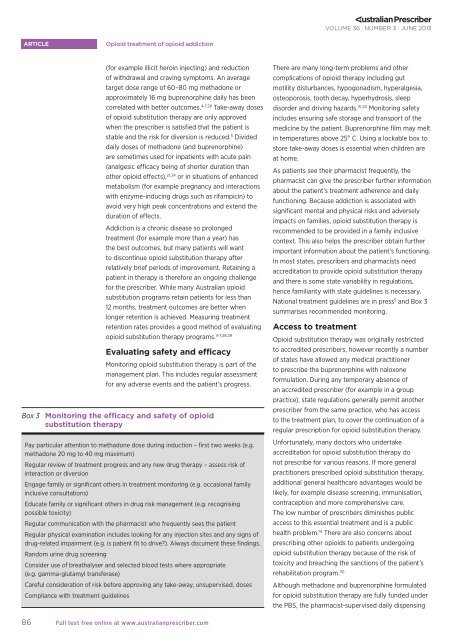download the full PDF issue - Australian Prescriber
download the full PDF issue - Australian Prescriber
download the full PDF issue - Australian Prescriber
You also want an ePaper? Increase the reach of your titles
YUMPU automatically turns print PDFs into web optimized ePapers that Google loves.
VOLUME 36 : NUMBER 3 : JUNE 2013<br />
ARTICLE<br />
Opioid treatment of opioid addiction<br />
(for example illicit heroin injecting) and reduction<br />
of withdrawal and craving symptoms. An average<br />
target dose range of 60–80 mg methadone or<br />
approximately 16 mg buprenorphine daily has been<br />
correlated with better outcomes. 4-7,28 Take-away doses<br />
of opioid substitution <strong>the</strong>rapy are only approved<br />
when <strong>the</strong> prescriber is satisfied that <strong>the</strong> patient is<br />
stable and <strong>the</strong> risk for diversion is reduced. 5 Divided<br />
daily doses of methadone (and buprenorphine)<br />
are sometimes used for inpatients with acute pain<br />
(analgesic efficacy being of shorter duration than<br />
o<strong>the</strong>r opioid effects), 21,24 or in situations of enhanced<br />
metabolism (for example pregnancy and interactions<br />
with enzyme-inducing drugs such as rifampicin) to<br />
avoid very high peak concentrations and extend <strong>the</strong><br />
duration of effects.<br />
Addiction is a chronic disease so prolonged<br />
treatment (for example more than a year) has<br />
<strong>the</strong> best outcomes, but many patients will want<br />
to discontinue opioid substitution <strong>the</strong>rapy after<br />
relatively brief periods of improvement. Retaining a<br />
patient in <strong>the</strong>rapy is <strong>the</strong>refore an ongoing challenge<br />
for <strong>the</strong> prescriber. While many <strong>Australian</strong> opioid<br />
substitution programs retain patients for less than<br />
12 months, treatment outcomes are better when<br />
longer retention is achieved. Measuring treatment<br />
retention rates provides a good method of evaluating<br />
opioid substitution <strong>the</strong>rapy programs. 4-7,28,29<br />
Evaluating safety and efficacy<br />
Monitoring opioid substitution <strong>the</strong>rapy is part of <strong>the</strong><br />
management plan. This includes regular assessment<br />
for any adverse events and <strong>the</strong> patient’s progress.<br />
Box 3 Monitoring <strong>the</strong> efficacy and safety of opioid<br />
substitution <strong>the</strong>rapy<br />
Pay particular attention to methadone dose during induction – first two weeks (e.g.<br />
methadone 20 mg to 40 mg maximum)<br />
Regular review of treatment progress and any new drug <strong>the</strong>rapy – assess risk of<br />
interaction or diversion<br />
Engage family or significant o<strong>the</strong>rs in treatment monitoring (e.g. occasional family<br />
inclusive consultations)<br />
Educate family or significant o<strong>the</strong>rs in drug risk management (e.g. recognising<br />
possible toxicity)<br />
Regular communication with <strong>the</strong> pharmacist who frequently sees <strong>the</strong> patient<br />
Regular physical examination includes looking for any injection sites and any signs of<br />
drug-related impairment (e.g. is patient fit to drive). Always document <strong>the</strong>se findings.<br />
Random urine drug screening<br />
Consider use of breathalyser and selected blood tests where appropriate<br />
(e.g. gamma-glutamyl transferase)<br />
Careful consideration of risk before approving any take-away, unsupervised, doses<br />
Compliance with treatment guidelines<br />
There are many long-term problems and o<strong>the</strong>r<br />
complications of opioid <strong>the</strong>rapy including gut<br />
motility disturbances, hypogonadism, hyperalgesia,<br />
osteoporosis, tooth decay, hyperhydrosis, sleep<br />
disorder and driving hazards. 15-20 Monitoring safety<br />
includes ensuring safe storage and transport of <strong>the</strong><br />
medicine by <strong>the</strong> patient. Buprenorphine film may melt<br />
in temperatures above 25° C. Using a lockable box to<br />
store take-away doses is essential when children are<br />
at home.<br />
As patients see <strong>the</strong>ir pharmacist frequently, <strong>the</strong><br />
pharmacist can give <strong>the</strong> prescriber fur<strong>the</strong>r information<br />
about <strong>the</strong> patient’s treatment adherence and daily<br />
functioning. Because addiction is associated with<br />
significant mental and physical risks and adversely<br />
impacts on families, opioid substitution <strong>the</strong>rapy is<br />
recommended to be provided in a family inclusive<br />
context. This also helps <strong>the</strong> prescriber obtain fur<strong>the</strong>r<br />
important information about <strong>the</strong> patient’s functioning.<br />
In most states, prescribers and pharmacists need<br />
accreditation to provide opioid substitution <strong>the</strong>rapy<br />
and <strong>the</strong>re is some state variability in regulations,<br />
hence familiarity with state guidelines is necessary.<br />
National treatment guidelines are in press 5 and Box 3<br />
summarises recommended monitoring.<br />
Access to treatment<br />
Opioid substitution <strong>the</strong>rapy was originally restricted<br />
to accredited prescribers, however recently a number<br />
of states have allowed any medical practitioner<br />
to prescribe <strong>the</strong> buprenorphine with naloxone<br />
formulation. During any temporary absence of<br />
an accredited prescriber (for example in a group<br />
practice), state regulations generally permit ano<strong>the</strong>r<br />
prescriber from <strong>the</strong> same practice, who has access<br />
to <strong>the</strong> treatment plan, to cover <strong>the</strong> continuation of a<br />
regular prescription for opioid substitution <strong>the</strong>rapy.<br />
Unfortunately, many doctors who undertake<br />
accreditation for opioid substitution <strong>the</strong>rapy do<br />
not prescribe for various reasons. If more general<br />
practitioners prescribed opioid substitution <strong>the</strong>rapy,<br />
additional general healthcare advantages would be<br />
likely, for example disease screening, immunisation,<br />
contraception and more comprehensive care.<br />
The low number of prescribers diminishes public<br />
access to this essential treatment and is a public<br />
health problem. 14 There are also concerns about<br />
prescribing o<strong>the</strong>r opioids to patients undergoing<br />
opioid substitution <strong>the</strong>rapy because of <strong>the</strong> risk of<br />
toxicity and breaching <strong>the</strong> sanctions of <strong>the</strong> patient’s<br />
rehabilitation program. 30<br />
Although methadone and buprenorphine formulated<br />
for opioid substitution <strong>the</strong>rapy are <strong>full</strong>y funded under<br />
<strong>the</strong> PBS, <strong>the</strong> pharmacist-supervised daily dispensing<br />
86<br />
Full text free online at www.australianprescriber.com
















